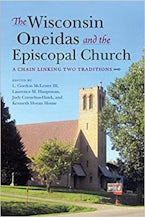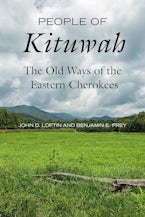- Home
- religion
- social science
- history
- The Wisconsin Oneida and the Episcopal Church

The Wisconsin Oneida and the Episcopal Church
A Chain Linking Two Traditions
Edited by: L. Gordon McLester, III, Laurence M. Hauptman, Judy Cornelius-Hawk and Kenneth Hoyan House
248 Pages
- Paperback
- ISBN: 9780253041388
- Published By: Indiana University Press
- Published: May 2019
$35.00
The Wisconsin Oneidas and the Episcopal Church: A Chain Linking Two Traditions tells the story of the Wisconsin Oneidas, a historical member nation of the Iroquois Confederacy, as they shifted from their religion and became largely Episcopalian. The book is an edited collection of essays focusing on the story of the Wisconsin Oneidas and their contact with British Anglican missionaries, the Christianization efforts by white settlers, and their membership in the Episcopal Church to the present day in Wisconsin. Throughout centuries of cooperation, the Wisconsin Oneidas and the Episcopal Church adapted towards one another, syncretizing together to establish a unique, intertwined community. The authors of the essays, comprised of local historians, community members, and academic historians, state in the introduction that they want the essays to engage with the heritage of the Oneida people, whose contact with European settlers forced cultural adaptation.
The book uses a metaphor, “the Covenant Chain,” to describe the treaties, alliances, and networks that created a relationship between the Iroquois Confederacy and the Episcopal Church. The essays attempt to accomplish this by reinforcing the “Covenant Chain” metaphor, which demonstrates the cooperation and syncretism between the Oneidas and the Episcopal Church over 300 years of interaction—between migration and syncretism of Christian beliefs with traditional Oneida Ojibwa beliefs and during various events relating to land policies impacting Oneidas, the Episcopal Church, and Wisconsin Oneidas worked together.
The essays in the book's first half provide a history of the Oneida people from their homeland in New York to their migration to the Michigan Territory. Michael Leroy Oberg’s essay “Flawed Sheppard” discusses John Henry Hobart and Eleazer Williams, critical Episcopal Church missionaries who encouraged and supported Oneida’s relocation to the Michigan Territory in the 1840s. Oberg drew on the “Covenant Chain” metaphor by the Oneida’s acceptance of Williams’ ministry when he preached in the Oneida language. The Episcopal Church mission gained major influence over the Oneida by utilizing a missionary who was fluent in their language, which made Oneidas more receptive to Episcopal Church teachings. By the 1810s, many settlers and New York state officials wanted the Oneida to relocate. Williams saw that relocation to the Michigan territory could offer the Oneida a haven away from white encroachment. With the people's trust, Williams led the first group of Oneidas to the Green Bay area. Oberg’s essay demonstrated how the Oneidas and the Episcopal Church grew in cooperation through relocation.
This essay encapsulates many of the aims and goals of the first half of the book. It establishes the foundation on which the Wisconsin Oneida society was constructed with its Episcopalian partners. Oberg discussed how Hobart’s role as bishop saw that Williams’ fluency and literacy in both Mohawk (the language close to the Oneida language) and English could make him an ideal candidate for reaching Oneida people and supporting the Episcopalian mission on Oneida land.
The second half of the book includes several oral histories from the 20th century that address church life, church leaders, and teachers at the mission school. The standout oral history in the volume is from a member of the Oneida Hymn Singers, L. Gordon McLester III, who toured around the US. McLester’s oral history best describes the themes of the oral histories when describing his experiences as a Hymn Singer. Hymn Singers were an ecumenical group that sang hymns in the Oneida language. The essay highlights hymn singing as a long-standing tradition in the Oneidas’ affiliation with the Episcopal church. Hymn singing in the Oneida community became a widespread practice when Eleazer Williams brought a hymnal used in church rituals. Though the hymnal was written in the Mohawk language, the Oneidas could use it, which became a part of their worship practices.
In addition, with encouragement from church leadership, Hymn Singers began touring parts of the Midwest in the mid-1800s, singing hymns in their native language. McLester’s oral history recalled his memory of the Hymn Singers travels in the 1980s – early 2000s. McLester recollected the excitement felt by the congregation upon the singers’ return. The hymn singing preserved the Oneida language and showcased their culture to the country. The long-standing practice of hymn singing in the Oneida language demonstrates a continued tradition where the Oneida culture has a place in their Episcopalian faith, adding another link in the “Covenant Chain.” The touring and interest of the hymn singers provided a place for Oneidas to share their language within the Episcopalian circuit.
The collection of essays reveals a long history of white Episcopalian contact that stretches back over 300 years. A key priority of the academic historians who contributed to the book was revising and updating The Oneidas by Julia Keen Bloomfield (James Stewart, 1907), the leading historical text on the Wisconsin Oneidas. However, the essays strongly build and advance academic works about the syncretism between Indigenous people and Christianity. For example, Allen Greer’s Mohawk Saint: Cathrine Tekakwitha and the Jesuits (Oxford University Press, 2006) describes the relationship between the Mohawk people (another Five Nation member of the Iroquois Confederacy) and Jesuit missionaries who used the story of the first Native North American, Saint Catherine Tekakwitha, as a token to show the potential religious potential of indigenous people. Being part of the Iroquois Confederacy, the Mohawks and Oneidas shared cultural and linguistic practices. Greer shows that European missionaries believed Mohawks had limited potential for full Christianization efforts and the inclusion of Christian Mohawks into Jesuit mission societies. Like Greer, the editors describe a similar story of the Oneidas’ contact with Episcopalian missionaries in the early 18th century. However, unlike in Greer’s case study, Oneidas became an extension of the Episcopal Church, and the Episcopalian missionaries and Oneidas came together under the leadership of Eleazer Williams. The authors of this book see more collaboration between European missionaries and Native peoples than Greer.
This book aims to demonstrate the cohesive efforts of two groups, the Oneidas, and Episcopalian missionaries, as they came together to build a coherent community. The legacy of the colonial era did not define the Wisconsin Oneidas but rather fostered a relationship with the Episcopalians that endured where both groups syncretized and cooperated into a vibrant religious tradition. Readers interested in indigenous communities located in the Midwest would benefit from reading this book.
Alexis Wilson is a doctoral student in history and religion at Claremont Graduate University.
Alexis WilsonDate Of Review:October 15, 2023
L. Gordon McLester III is former Secretary of the Oneida Nation of Indians of Wisconsin and Director of the Oneida Indian Historical Society.
Laurence M. Hauptman is SUNY Distinguished Professor Emeritus of History.
Judy Cornelius-Hawk is former Treasurer, Tribal Librarian, and member of the Land Claims Committee of the Oneida Nation of Indians of Wisconsin
Kenneth Hoyan House is Chaplain of the Wisconsin Oneida Veterans of Foreign Wars.











